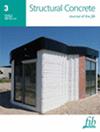Experimental and numerical investigation of the bending, shear, and punching shear behavior of recycled aggregate concrete precast/prestressed hollow core slabs
IF 3.3
3区 工程技术
Q2 CONSTRUCTION & BUILDING TECHNOLOGY
引用次数: 0
Abstract
Although it has been shown that using recycled concrete aggregate in new structural concrete is economical and sustainable, the use of this material for such applications is still not widespread. One of the reasons is that manufacturers, designers, engineers, owners, and other market players are not familiar with specifying and utilizing this material—although standards are starting to incorporate provisions for recycled aggregate concrete, successful, practical example projects are needed. The current paper describes the results of a partnership between universities and a precast concrete manufacturer of hollow core slabs. Seven hollow core slabs with volumetric replacement ratios of natural aggregate with recycled aggregate from 0% to 60% were tested to failure in both bending and shear, and then undamaged portions of the slabs were subjected to punching shear until failure. The results showed only mild differences in strength, with different replacement percentages of recycled aggregate under the various loading scenarios. Numerical simulations performed in Abaqus demonstrated the feasibility of analyzing recycled aggregate concrete structural elements and provided important insights into their behavior.再生骨料混凝土预制/预应力空心板弯曲、剪切和冲剪行为的实验和数值研究
尽管事实证明,在新结构混凝土中使用再生混凝土骨料既经济又可持续,但这种材料的应用仍不广泛。其中一个原因是,制造商、设计师、工程师、业主和其他市场参与者并不熟悉如何指定和使用这种材料--尽管标准中已开始纳入有关再生骨料混凝土的规定,但仍需要成功的实用范例项目。本文介绍了大学与空心楼板预制混凝土制造商之间的合作成果。对天然骨料与再生骨料体积替代率从 0% 到 60% 的七种空心板进行了弯曲和剪切失效测试,然后对未损坏的部分进行冲剪测试,直至失效。结果表明,在各种加载情况下,不同的再生骨料替代率在强度上仅存在轻微差异。在 Abaqus 中进行的数值模拟证明了分析再生骨料混凝土结构元件的可行性,并为了解其行为提供了重要依据。
本文章由计算机程序翻译,如有差异,请以英文原文为准。
求助全文
约1分钟内获得全文
求助全文
来源期刊

Structural Concrete
CONSTRUCTION & BUILDING TECHNOLOGY-ENGINEERING, CIVIL
CiteScore
5.60
自引率
15.60%
发文量
284
审稿时长
3 months
期刊介绍:
Structural Concrete, the official journal of the fib, provides conceptual and procedural guidance in the field of concrete construction, and features peer-reviewed papers, keynote research and industry news covering all aspects of the design, construction, performance in service and demolition of concrete structures.
Main topics:
design, construction, performance in service, conservation (assessment, maintenance, strengthening) and demolition of concrete structures
research about the behaviour of concrete structures
development of design methods
fib Model Code
sustainability of concrete structures.
 求助内容:
求助内容: 应助结果提醒方式:
应助结果提醒方式:


